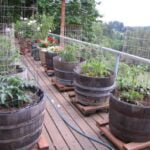Are you looking for some inspiration for your garden? Whether you are a seasoned gardener or just starting out, this article on vegetables for gardens ideas will provide you with valuable insights on how to make the most of your gardening experience. Growing vegetables in your own garden not only allows you to enjoy fresh and flavorful produce but also offers numerous benefits for your health and well-being.
One of the key advantages of growing your own vegetables is the opportunity to have a constant supply of nutritious and organic food right at your fingertips. By cultivating a variety of vegetables in your garden, you can ensure that you have access to fresh ingredients for cooking and eating. Additionally, gardening can be a therapeutic and rewarding activity that helps reduce stress and promote mental well-being.
In this article, we will explore various aspects of vegetable gardening, including the best vegetables for beginner gardeners, seasonal planting guides, vertical gardening ideas, companion planting tips, container gardening options, unique vegetable varieties to try, succession planting strategies, and harvesting and storage techniques. Whether you have a large backyard or limited space in an urban environment, there are plenty of creative ways to grow delicious and healthy vegetables at home.
Let’s dive into the wonderful world of vegetable gardening and discover how you can cultivate a bountiful harvest right in your own backyard.
Best Vegetables for Beginner Gardeners
For beginner gardeners, starting with easy-to-grow vegetables is a great way to build confidence and experience success in your gardening endeavors. Here are some vegetables for gardens ideas that are perfect for those just starting out:
Tomatoes
Tomatoes are a popular choice for beginner gardeners because they are relatively low-maintenance and produce bountiful harvests. They can be grown in containers or in the ground, as long as they have plenty of sunlight. There are many varieties to choose from, including cherry tomatoes, beefsteak tomatoes, and heirloom varieties.
Green Beans
Green beans are another easy-to-grow vegetable that is perfect for beginners. They can be sown directly into the soil and don’t require much maintenance besides regular watering. Green beans also do well in containers if space is limited in your garden.
Zucchini
Zucchini is a prolific vegetable that thrives in most growing conditions. It’s a fast-growing plant that produces an abundance of squash throughout the season. Zucchini plants do well when planted in full sun with fertile, well-draining soil. They can also be grown vertically to save space in the garden.
By starting with these easy-to-grow vegetables, beginner gardeners can enjoy a successful gardening experience while learning valuable skills that can be applied to more challenging crops in the future. Don’t be afraid to experiment with different varieties and techniques to find what works best for your unique gardening situation.
Seasonal Planting Guide
When it comes to growing vegetables in your own garden, timing is key. Knowing when to plant different vegetables throughout the year can make a significant impact on their growth and yield. By following a seasonal planting guide, you can ensure that your vegetables thrive and produce bountiful harvests.
Spring Planting
In the spring, it’s time to plant cool-season crops such as lettuce, spinach, peas, radishes, and broccoli. These vegetables prefer cooler temperatures and can tolerate light frosts. Start these plants as soon as the soil can be worked for an early spring harvest.
Summer Planting
As the weather warms up, it’s time to transition to warm-season crops like tomatoes, peppers, cucumbers, squash, and beans. These vegetables require heat and plenty of sunlight to grow successfully. Wait until after the last frost date in your area before planting these summer favorites.
Fall Planting
Fall is the perfect time to plant a second round of cool-season crops for a late harvest. Vegetables like carrots, beets, kale, and turnips thrive in cooler temperatures and will benefit from the mild conditions of the fall season. Extend your growing season by planting these vegetables in late summer for a fall harvest.
By following a seasonal planting guide tailored to your region, you can maximize the success of your vegetable garden. Consider rotating crops each year to prevent disease build-up in the soil and ensure healthy plants. With proper planning and knowledge of when to plant different vegetables, you’ll be on your way to a productive garden filled with fresh produce throughout the year.
Vertical Gardening Ideas
When space is limited in your garden, vertical gardening can be a great solution to maximize the area you have available. By growing climbing vegetables, you can make use of vertical structures like trellises, arbors, or even simple stakes to support the plants as they grow upwards. Not only does this help save space, but it also adds a beautiful aesthetic element to your garden.
Here are some popular climbing vegetables that are well-suited for vertical gardening:
- Pole beans: These easy-to-grow vegetables produce long vines that can be trained to climb up a trellis or pole. They not only provide a bountiful harvest but also add a decorative touch with their lush green leaves and vibrant beans.
- Peas: Another excellent choice for vertical gardening, peas grow quickly and produce delicious pods that are perfect for fresh snacking or cooking. By providing a sturdy support structure, such as a pea fence or netting, you can enjoy a continuous harvest throughout the season.
- Cucumbers: Growing cucumbers vertically not only saves space but also helps prevent diseases by keeping the fruit off the ground. With proper support and regular pruning, cucumber plants will thrive and yield plenty of crisp and refreshing fruits.
In addition to these common climbing vegetables, consider experimenting with other varieties such as squash, melons, or even tomatoes in a vertical gardening setup. The key is to provide adequate support for the plant’s growth while ensuring proper spacing between each vine to prevent overcrowding. With some creativity and careful planning, you can transform your garden into a lush vertical oasis full of thriving climbing vegetables.
Companion Planting Tips
Companion planting is a gardening technique that involves planting different types of plants in close proximity to one another to benefit growth, deter pests, and promote overall health in the garden. By carefully selecting which vegetables to plant together, you can create a harmonious ecosystem that maximizes the potential of your garden. Some common companion planting combinations include tomatoes and basil, carrots and onions, and squash and beans.
One of the key benefits of companion planting is pest control. Certain plants have natural properties that repel harmful insects or attract beneficial ones. For example, planting garlic near roses can help deter aphids, while marigolds are known for their ability to repel nematodes in the soil. By strategically pairing vegetables with compatible companions, you can reduce the need for chemical pesticides and create a more sustainable garden environment.
In addition to pest control, companion planting can also enhance the growth and flavor of your vegetables. Some plant combinations have symbiotic relationships where they provide mutual benefits to each other. For instance, planting peas near corn can help support the corn’s stalks as they grow taller, while the corn provides shade for the peas.
The result is healthier plants with improved productivity and taste. So next time you plan your garden layout, consider incorporating companion planting strategies to optimize your vegetable harvest.
Container Gardening
When choosing containers for your vegetable garden, opt for ones that are at least 10-12 inches deep to allow for proper root growth. You can use plastic pots, ceramic planters, wooden boxes, or even recycled containers as long as they have drainage holes at the bottom to prevent waterlogging.
Additionally, consider the size of the mature plant when selecting a container and ensure that it has enough space to accommodate the roots and allow for sufficient airflow around the plant.
Some popular vegetables that thrive in container gardens include tomatoes, peppers, lettuce, radishes, beans, and herbs like basil and parsley. These crops are well-suited to growing in confined spaces and offer a rewarding harvest even with limited room.
Remember to provide adequate sunlight (at least 6-8 hours per day), regular watering, and appropriate fertilization to help your container vegetables flourish. With a little creativity and resourcefulness, you can enjoy fresh produce grown right at home regardless of your living situation.
Unique Vegetable Varieties to Try
When it comes to choosing what to grow in your vegetable garden, there are a plethora of unique and uncommon options that can add excitement and diversity to your harvest. One such option is the Romanesco broccoli, also known as Roman cauliflower, with its stunning appearance resembling a fractal pattern. This vegetable not only looks intriguing but also offers a nutty flavor that sets it apart from traditional broccoli varieties.
For those looking to spice up their salads, consider planting watermelon radishes. These radishes have a vibrant pink flesh that adds a pop of color to any dish. Their mild peppery flavor makes them a favorite among chefs and home cooks alike. Additionally, they are rich in antioxidants and vitamin C, providing both visual appeal and nutritional benefits to your garden.
If you’re interested in exploring exotic flavors, why not try growing purple carrots? Unlike their orange counterparts, purple carrots contain anthocyanins, which give them their distinctive hue and offer potential health benefits. Whether roasted, steamed, or enjoyed raw, these colorful carrots can bring an unexpected twist to your culinary creations while contributing to a rainbow of colors in your garden.
| Vegetable Variety | Unique Feature |
|---|---|
| Romanesco Broccoli | Fractal pattern appearance and nutty flavor |
| Watermelon Radishes | Vibrant pink flesh with mild peppery flavor |
| Purple Carrots | Distinctive purple color due to anthocyanins with potential health benefits |
Succession Planting Strategies
Succession planting is a valuable strategy for gardeners who want to ensure a continuous harvest throughout the growing season. By staggering the planting of vegetables at regular intervals, you can extend your harvest and enjoy a steady supply of fresh produce. This technique also helps prevent overwhelming gluts of vegetables that may go to waste if harvested all at once.
One key aspect of succession planting is understanding the maturity rates of different vegetable crops. Some vegetables, like lettuce and radishes, have quick growth cycles and can be planted in succession every few weeks. Others, such as tomatoes and peppers, have longer growing seasons and may require more strategic planning to ensure a continuous harvest.
Another important factor to consider in succession planting is crop rotation. By rotating the types of vegetables you plant in each bed or container throughout the season, you can minimize soil-borne diseases and pests while also maintaining the health of your garden ecosystem. This practice can help improve soil fertility and reduce the need for synthetic fertilizers.
| Vegetable | Succession Planting Interval |
|---|---|
| Lettuce | Every 2-3 weeks |
| Green Beans | Every 2-4 weeks |
| Zucchini | Every 3-4 weeks |
Overall, succession planting is a versatile technique that allows gardeners to make the most of their growing space and maximize their harvests throughout the season. Whether you have a small backyard garden or are gardening in containers on a balcony, implementing succession planting strategies can help you enjoy a bountiful supply of homegrown vegetables. Be sure to plan ahead, keep track of planting dates, and adapt your schedule based on the specific needs of each vegetable crop for optimal results.
Harvesting and Storage
In conclusion, growing vegetables in your own garden not only provides you with fresh and nutritious produce but also offers a rewarding and fulfilling experience. By following the tips and ideas shared in this article, you can ensure a successful vegetable garden and enjoy the benefits of homegrown vegetables all season long.
From easy-to-grow options for beginners to unique vegetable varieties that add excitement to your garden, there are endless possibilities when it comes to selecting vegetables for your garden. Whether you have limited space or are looking to maximize your harvest, there are creative solutions such as vertical gardening and container gardening that can help you make the most of your gardening efforts.
By incorporating companion planting techniques and succession planting strategies, you can enhance growth, reduce pests, and ensure a continuous harvest throughout the season. And once it’s time to harvest your vegetables, proper storage techniques will help preserve the fruits of your labor so you can enjoy them even after the growing season has ended. With these tips and ideas for growing vegetables in your garden, you’ll be on your way to a bountiful harvest in no time.
Frequently Asked Questions
What Vegetables Should You Have in Your Garden?
Having a variety of vegetables in your garden is important for a well-rounded harvest. Consider including tomatoes, peppers, cucumbers, zucchini, lettuce, carrots, and herbs like basil and parsley. These vegetables offer a mix of flavors, textures, and nutrients.
What Are the Easiest Veggies to Grow in Garden?
When it comes to easy-to-grow vegetables, radishes are a great option for beginners due to their quick growth and minimal maintenance requirements. Other simple veggies to consider are lettuce, green beans, cherry tomatoes, and zucchini. These plants typically don’t require much fuss and can thrive in various growing conditions.
What Grows Well Together in a Vegetable Garden?
Certain vegetables thrive when grown together due to their complementary growing habits or benefits they provide each other. For example, planting tomatoes alongside basil can help improve the flavor of the tomatoes while deterring pests naturally. Carrots and onions are also good companions because they don’t compete for space underground and can help keep pests away from each other.
Additionally, planting beans near corn provides structural support for the beans while the beans fix nitrogen in the soil that benefits the corn plant’s growth. Consider companion planting when planning out your vegetable garden to maximize productivity and health of your plants.

If you’re looking to get into vegetable gardening, or are just looking for some tips on how to make your current garden better, then you’ve come to the right place! My name is Ethel and I have been gardening for years. In this blog, I’m going to share with you some of my best tips on how to create a successful vegetable garden.





